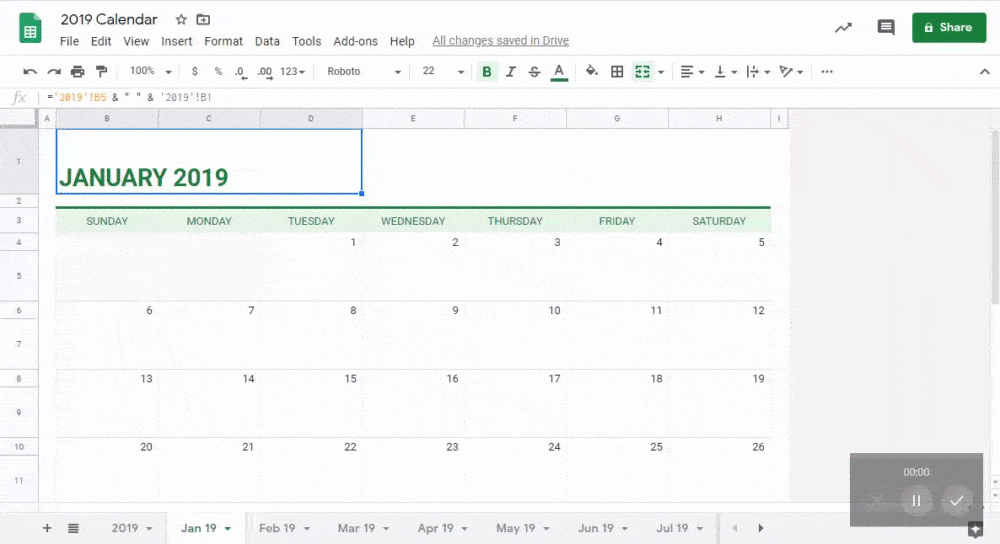-
 9 min. read
9 min. read
-
 Macy Storm
Macy Storm Content Marketing Consultant
Content Marketing Consultant
- Macy is a content marketing consultant with over five years of experience creating content for dozens of industries including home services, recreation, and education. She’s written about every marketing topic under the sun, from SEO to AI to email marketing. Her work has been featured by Search Engine Journal, HubSpot, Entrepreneur, Clutch, and more. In her free time, Macy enjoys crafting, reading comic books, and walking her dog Daisy.
If you’re investing in marketing strategies, you need to have a marketing calendar to help you stay organized and on top of your marketing tactics. But if you don’t know how to plan a marketing calendar, you may struggle to use it effectively. Luckily, we’ve got the information to help you create a useful marketing calendar.
Keep reading to learn why you need a marketing calendar and eight easy steps for getting started. To stay up to date on all things marketing, subscribe to Revenue Weekly!
Why is a marketing calendar important?
So, why do you even need a marketing calendar? Check out these three reasons marketing calendars are critical to your business’s success.
1. It helps you stay organized
You need to know how to plan a marketing calendar because it will help you stay organized with your marketing campaigns. When you’re running multiple campaigns at once, it’s easy for you to get lost or confused. Since you want to have a cohesive marketing campaign, you must use a marketing calendar to help you stay organized.
A marketing calendar will help you know when you’re posting content, social media posts, or sending emails. It enables you to keep track of when you’re launching campaigns and when you’re running them. You’ll have an overview of your marketing campaign that allows you to coordinate your strategies.
2. It helps you remain consistent
When you use a digital marketing calendar, you help your brand stay consistent. The most effective marketing strategies are consistent, and a marketing calendar is a great way to ensure that your business stays on top of every campaign. You want to be consistent with marketing because it helps people remember your brand better.
When you post content frequently, you increase brand exposure to your audience, and they become more likely to remember your business. A digital marketing calendar will help you stay on top of posting content often, so you can continue to build brand recognition with your audience.
3. It helps you create more cohesive campaigns
When you run different marketing campaigns, you want them to be cohesive. If you run a social media campaign and an email marketing campaign, you want them to work together. When you use a marketing calendar to manage multiple marketing campaigns, you can gain insight into important performance data — allowing you to understand how your campaigns work together.
Not only that, but after considering the data, it’ll help you understand how you can make your campaigns more cohesive, or how they could better work together for success.
How to plan a marketing calendar
Are you ready to start learning how to create a marketing calendar? Check out these eight steps for getting started!
Step 1. Choose where you’re going to host your calendar
The first step to creating a marketing calendar is deciding where you’re going to create it. While you have the option to do it by hand, it’s recommended that you create an electronic version of your calendar. An electronic version will take less time to make, and there is less likelihood that it will get lost or destroyed.
You can also share an electronic version with other coworkers on other teams. There are numerous places you can create your marketing calendar:
- Microsoft Excel or Word
- Google Sheets
- Software specifically for Calendars

You’ll want to choose which option you think works best for your company. Generally, Google Sheets is an excellent option. Especially if you have multiple people working on the calendar and they need to access it from different areas.
Step 2. Define your goals
Before diving into the nitty-gritty of your calendar, you need to define your goals. It’s essential to define your goals, so that you know what you’re working toward. Your goals should focus on what you want to achieve with your campaigns.
You can set goals that focus on:
- Gaining new leads
- Earning sales
- Increasing brand exposure
- And more
By setting these goals, you will know what strategies you’re going to invest in and include in your calendar and budget.
Discover: Marketing Budget Examples
Step 3. Identify your marketing strategies
The next step in how to create a marketing calendar is identifying your marketing strategies. If you’re going to have a marketing calendar, you need to know what strategies you’re putting on that calendar. Here are some common strategies that appear on digital marketing calendars:
- PPC advertising: PPC ads are paid advertisements that appear at the top of search results, above organic listings. You can incorporate this strategy into your marketing calendar, planning when to run ads for specific products or services while considering the PPC pricing associated with each campaign.
- Email marketing: Email marketing is a strategy that enables you to send emails directly to subscribers and personalize their experience. You can plan when to send emails, from new product releases to product sales, to help you reach your audience at the right time.
- Social media marketing: Social media marketing involves creating content and sharing posts on your social media profiles. With a digital marketing calendar, you can plan when to post content on social media and coordinate it with other marketing strategies.
- Content marketing: Content marketing is a strategy that focuses on developing and sharing content with your audience. With your digital marketing calendar, you can plan what types of content to post and when to post them.
When you identify your marketing strategies, you’ll know what to plan for on your marketing calendar.
Step 4. Establish your target audience
Once you establish your strategies, you’ll want to establish your target audience. It’s essential to know your target audience, so you know how to use your strategy best. If you don’t have your target audience established, you need to think of your typical customer.
Look at who comes into your store or buys from you online. You’ll want to look at common characteristics from these customers, including:
- Age
- Gender
- Buying habits
- Interests
- Hobbies
- Occupation
- Socioeconomic status
- And more
By defining these characteristics, you’ll have a better understanding of who typically purchases from your business. It will allow you to use strategies that will help you reach those leads. 
Step 5. Chart your selling cycle
Now that you’ve got all the basic components, like your audience, strategies, and goals, you can start developing components for your marketing calendar. If you want to know how to plan a marketing calendar successfully, begin by charting your selling cycle. With your 12-month blank calendar in front of you, it’s time to document your selling cycle.
The selling cycle accounts for the seasonality of your products. For example, let’s say you sell school backpacks. While your products can be bought year-round, the highest sales season is right before school starts up again at the end of August or early September.
So, in the month or two leading up to back to school, you’ll experience your peak sales on backpacks. It’s important to note a seasonal change like this in your sales cycle because you’ll want to ensure that you have your marketing efforts coordinated for these peak times of the year. If you have products that fluctuate with the seasons, it’s significant to note that in your marketing calendar, too.
For example, a sports store would want to notate what time of the season different sports gear is needed. They would note that baseball products sell in the months before spring and football products sell in the months before fall. It’s important to note this information, so you can create marketing campaigns that correspond with the time of year.
Step 6. Identify important dates
If you want to know how to plan a marketing calendar, you need to add important dates to the marketing calendar. Some of these important dates include:
- Holidays
- Milestones within your company
- Launch of a new product or service
- Company events
- And more
It’s important to note these dates so, if you want to, you can coordinate marketing campaigns So, for example, if your company’s 50th anniversary is coming up, you may hold exclusive sales to send to your customers, like Redner’s Warehouse Markets did.  To commemorate their anniversary, they tactfully planned to send emails each day to loyal customers with a special deal of the day for specific food items. So, it’s essential to identify these dates before you start planning your marketing strategies on your calendar, so you can create coinciding campaigns.
To commemorate their anniversary, they tactfully planned to send emails each day to loyal customers with a special deal of the day for specific food items. So, it’s essential to identify these dates before you start planning your marketing strategies on your calendar, so you can create coinciding campaigns.
Step 7. Identify how long projects within your campaign will take
Now that you know what strategies you’re using, you can start thinking about the type of campaigns you’re running. As you gather ideas for your campaign and get excited to put them on the calendar, think about how long the projects will take. One critical component of how to create a marketing calendar is planning your projects properly.
For many marketing projects, you’ll need more than just a day to work on them. You must plan every step of your projects on your calendar. Let’s go back to that example of the school backpacks.
You decide that you want to create an infographic that details how to find the right bag for school. To create this infographic, you need to consider how long it will take to make it, including revision time. When you create your digital marketing calendar, you’ll want to set deadlines for each part of the project.
With this infographic, you could set a deadline for the first round of editing, the second round of editing, and publishing. By knowing the progress of the project, you can better plan for it and use your marketing calendar more productively.
WebFX helps companies like yours reach their business goals
“Our marketing department has a lot of key performance indicators that WebFX has always helped us achieve… WebFX has always worked hard to make sure that we’re getting what we need out of the partnership, not just what may seem like the best result.”
HydroWorx
See Case StudyStart creating your digital marketing calendar today
If you’re ready to start planning and getting your digital marketing calendar in shape, WebFX is here to help. We’re an award-winning full-service digital marketing agency and the best Baltimore digital marketing agency.
With over a decade of experience, we know how to help you choose the right marketing strategies and organize your campaigns to maximize effectiveness. Give us a call today at 888-601-5359 or contact us online to speak with a strategist!
-
 Macy is a content marketing consultant with over five years of experience creating content for dozens of industries including home services, recreation, and education. She’s written about every marketing topic under the sun, from SEO to AI to email marketing. Her work has been featured by Search Engine Journal, HubSpot, Entrepreneur, Clutch, and more. In her free time, Macy enjoys crafting, reading comic books, and walking her dog Daisy.
Macy is a content marketing consultant with over five years of experience creating content for dozens of industries including home services, recreation, and education. She’s written about every marketing topic under the sun, from SEO to AI to email marketing. Her work has been featured by Search Engine Journal, HubSpot, Entrepreneur, Clutch, and more. In her free time, Macy enjoys crafting, reading comic books, and walking her dog Daisy. -

WebFX is a full-service marketing agency with 1,100+ client reviews and a 4.9-star rating on Clutch! Find out how our expert team and revenue-accelerating tech can drive results for you! Learn more
Try our free Marketing Calculator
Craft a tailored online marketing strategy! Utilize our free Internet marketing calculator for a custom plan based on your location, reach, timeframe, and budget.
Plan Your Marketing Budget

Proven Marketing Strategies

Proven Marketing Strategies
Try our free Marketing Calculator
Craft a tailored online marketing strategy! Utilize our free Internet marketing calculator for a custom plan based on your location, reach, timeframe, and budget.
Plan Your Marketing Budget
What to read next





